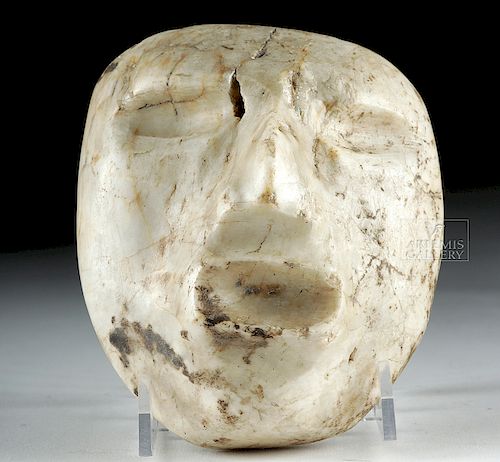Rare Guerrero Chontal White Marble Mask
Lot 200
About Seller
Artemis Gallery
686 S Taylor Ave, Ste 106
Louisville, CO 80027
United States
Selling antiquities, ancient and ethnographic art online since 1993, Artemis Gallery specializes in Classical Antiquities (Egyptian, Greek, Roman, Near Eastern), Asian, Pre-Columbian, African / Tribal / Oceanographic art. Our extensive inventory includes pottery, stone, metal, wood, glass and textil...Read more
Estimate:
$4,000 - $6,000
Absentee vs Live bid
Two ways to bid:
- Leave a max absentee bid and the platform will bid on your behalf up to your maximum bid during the live auction.
- Bid live during the auction and your bids will be submitted real-time to the auctioneer.
Bid Increments
| Price | Bid Increment |
|---|---|
| $0 | $25 |
| $300 | $50 |
| $1,000 | $100 |
| $2,000 | $250 |
| $5,000 | $500 |
| $10,000 | $1,000 |
| $20,000 | $2,500 |
| $50,000 | $5,000 |
| $100,000 | $10,000 |
| $200,000 | $20,000 |
About Auction
By Artemis Gallery
Jan 7, 2020
Set Reminder
2020-01-07 10:00:00
2020-01-07 10:00:00
America/New_York
Bidsquare
Bidsquare : VARIETY AUCTION - Antiquities / Ethnographic
https://www.bidsquare.com/auctions/artemis-gallery/variety-auction---antiquities-ethnographic-4787
Around the world & back in time - be amazed at the treasures you will find. Antiquities from Egypt, Greece, Italy and the Near East, Asian, Pre-Columbian, African / Tribal / Oceanic, Native American, Spanish Colonial, Russian Icons, Fine Art, much more! Artemis Gallery info@artemisgallery.com
Around the world & back in time - be amazed at the treasures you will find. Antiquities from Egypt, Greece, Italy and the Near East, Asian, Pre-Columbian, African / Tribal / Oceanic, Native American, Spanish Colonial, Russian Icons, Fine Art, much more! Artemis Gallery info@artemisgallery.com
- Lot Description
**Originally Listed At $2500**
Pre-Columbian, Central Mexico, Guerrero region, Chontal, Late Preclassic period, ca. 300 to 100 BCE. A fascinating face mask, made of rare white marble (most are made of greenstone), with deep impressions for the nose and mouth, raised eyelids and lips, and a sturdy, wide nose projecting from the center of the face. The cheeks are smooth, even hollowed, and the mouth is open above a slightly pointed chin. The back is pierced in four places for suspension, with a fifth drill hole that does not go fully through the stone. Size: 4.25" W x 4.7" H (10.8 cm x 11.9 cm)
The Guerrero region of modern-day southwestern Mexico was the center of the Mezcala and Chontal stone carving traditions. While Mezcala artists are known for their abstract, geometric style, the Chontal sculptors imbued their artworks with more naturalism. Although their stonework stems from the Preclassic period, ca. 300 to 100 BCE, later Mesoamerican peoples clearly cherished Chontal portable sculptures as heirlooms. Chontal creations have been unearthed in ritual caches at Templo Mayor, the principle temple of the 15th century Aztecs of Tenochtitlan (Mexico City).
What's more, legendary 20th century modernists such as Diego Rivera, Frida Kahlo, and Miguel Covarrubias appreciated the minimalist qualities of Chontal art. Covarrubias went so far as to compare it to the Cycladic style of ancient Greece. Scholars believe that such masks as this example were tied to funerary bundles of the noble elite; however, smaller scale masks suggest they may have been attached to clothing.
Provenance: private Hawaii, USA collection; ex-Palmyra Heritage Gallery, New York, USA, 2000s
All items legal to buy/sell under U.S. Statute covering cultural patrimony Code 2600, CHAPTER 14, and are guaranteed to be as described or your money back.
A Certificate of Authenticity will accompany all winning bids.
We ship worldwide and handle all shipping in-house for your convenience.
#138268Deep encrustations and surface wear commensurate with age. Fissure on the inner side of one eye that looks like it was a natural crack in the rock.Condition
- Shipping Info
-
All shipping is handled in-house for your convenience. Your invoice from Artemis Gallery will include shipping calculation instructions. If in doubt, please inquire BEFORE bidding for estimated shipping costs for individual items.
-
- Buyer's Premium



 EUR
EUR CAD
CAD AUD
AUD GBP
GBP MXN
MXN HKD
HKD CNY
CNY MYR
MYR SEK
SEK SGD
SGD CHF
CHF THB
THB














